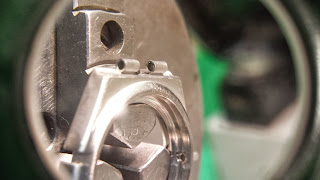This week I've been working on forming my own 'balance complete'. All
you get are the parts you need: balance wheel, balance staff, collet,
roller table, hairspring, and pins. First one must rivet the balance wheel to the staff, then press on the roller table and make sure they are true (flat). Then using a ruby-jawed vice you must 'poise' the balance to make sure the weight is evenly distributed along the whole diameter of the wheel.
Once the wheel is set you need to take the hairspring and either snap it or pin it to the collet, press the collet onto the balance wheel and then, using a counting platform find the 'counting point' of the spring. This is the point where the springs length, when paired with a certain balance produces the desired vibrations, in this case 18,000/hr. Once this point has been located, you mark the position by clipping off the excess spring 1 coil further along the spring (as the spring is too long for the job anyway)
Poising the hairspring is the tricky part, it involves lining up the point of attachment of the spring to the collet and the counting point as close as possible on one side of the hairspring. This is accomplished using 'Leroy's method'. Basically you take the angle from the counting point to the point of attachment following the spring (a) then take (a/3)=b, then take (b+a)= new point of attachment. So just take your current point of attachment, move forward along the spring in that many degrees to find your new point of attachment. If you measured correctly it will poise the spring. Keep in mind you want to subtract about 60dgs from the above number for your actual cut because you need extra spring to fit inside the collet.
So now you should center and flatten your hairspring on its collet then put a bridge with a pinnable stud in a watch. Push your hairspring through the stud and loosely pin it there. Get it into the ballpark, meaning your new counting point (which you have now checked using the counting platform) should be in the vicinity of the regulating pins. Then use your timing machine in frequency mode while slowly adjusting the amount of spring coming through the stud. Once you are within 10 vibrations either side of your target drive the pin home and cut off excess spring.
Now you can busy yourself with forming the dogleg which will interact with the pins, lead to the stud and allow the spring to breathe more freely. I did this using a tool I created for this particular job.
Lastly, install everything into the watch, make sure everything is still flat and centered, set up your regulating pins and then regulate the watch to a good time. If everything went smoothly and you didn't muck anything up you now have a working hairspring.
 |
| Truing the balance wheel |
 |
| Pressing on the roller table |
 |
| Using the poising tool |
 |
| More poising |
 |
| Pinning the collet to the hairspring |
 |
| The vibrating tool |
 |
| Another shot of the vibrating tool |
 |
| Here's the first hairspring I made in the watch, it keeps fairly good time for a first try! |
 |
| This is a neat little steel template I created to help in forming the dogleg accurately. The desired radius is scribed into the hardened metal and the 120dg desired angle is also scribed. One simply has to screw the hairspring collet into the recessed hole then begin manipulation. The steel is hardened to prevent tweezers scratching the metal while working. |
 |
| Finally a old Elgin I fixed up for a customer. When it came in it had no minute hand, crystal and was not running. Works great now. |




















































